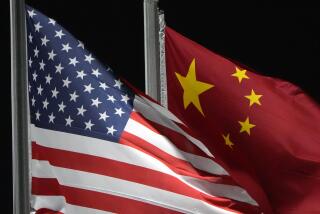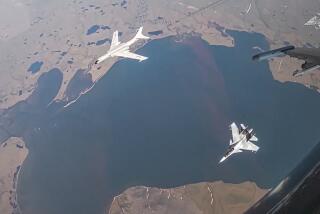China Seeks Russian Weapons : Arms: Shunned by U.S., Beijing is turning to hard-pressed former Soviet industries in effort to modernize its military. The result could affect Asian power balances.
- Share via
WASHINGTON — China is engaged in an extensive effort to buy advanced military hardware from hard-pressed Russian defense industries and to obtain technology from Russian scientists, say concerned U.S. officials and some Russian and Chinese defense specialists.
In a major effort by China to modernize its military capability, the country is in some instances buying military supplies by dealing directly with individual factories throughout Russia, rather than by going through Moscow.
The Russian supplies in some cases are enabling Beijing to get sophisticated military technology that it has been unable to buy from the West since the Bush Administration clamped down on sales of such technology to China after the bloody army crackdown on pro-democracy demonstrators in Beijing in 1989, observers say.
The most visible part of the new Russian-Chinese military cooperation was a sale recently completed by Moscow to Beijing of 24 Sukhoi 27 warplanes, aircraft that are far more advanced than anything the Chinese air force previously owned.
And according to U.S. officials, the often-clandestine Chinese campaign for military acquisitions in Russia now extends well beyond the Sukhoi 27s. “They’re looking at MIG-31s and a whole set of new weapons and technology of mass destruction,” including missile-guidance systems and nuclear-fusion technology, one senior official said.
Increased military power resulting from these purchases could make it easier for China to intimidate its neighbors in Southeast Asia, Taiwan and Japan and, some U.S. experts say, could eventually pose a threat to U.S. interests in Asia and the Pacific.
“There are strategic consequences to the idea that Russia would become a principal arms supplier to China,” said Jonathan Pollack, an expert on Asian military affairs at RAND Corp.
“It may give them more options, more of a power-projection capability than they had in the past,” Pollack said. “Depending on the kind of China we’re dealing with, that could have major implications for our security interests in the Western Pacific.”
Speaking of the Chinese defense buildup, another senior American official said the Bush Administration has recently been going out of its way to reassure officials in Beijing that the United States does not view China as an enemy, despite hostility voiced in Congress about China’s policies on human rights, trade and weapons proliferation.
Since the collapse of the Soviet Union, the United States has often voiced concern about the possible outflow of advanced Soviet military technology. However, it is not clear how much control the government of President Boris N. Yeltsin has over the sales to China.
“The producers are now more or less independent. And they have their own independent lobby,” Andrei V. Kouzmenko of Russia’s Institute of World Economy and International Relations said at a recent conference in Hong Kong sponsored by UC San Diego’s Institute on Global Conflict and Cooperation.
The current conditions in Russia are giving China a rare chance to obtain some of the sophisticated military items that the People’s Liberation Army was seeking from the West before 1989.
“After the Gulf War, Chinese leaders pushed very hard to modernize (the PLA). They saw the importance of high-tech weapons,” one knowledgeable Chinese source says. “The U.S. government had sanctions (on military sales to China), and there was no way the Chinese government could buy new weapons from the West.”
Moreover, the Russian wares are now selling at what Pollack and several other analysts termed “fire-sale prices.”
“If you can buy a $20-million aircraft for $15 million and your military modernization is already overdue, then it’s a good time to do so,” observed Paul Kreisberg, an Asia specialist at the East-West Center in Honolulu. In addition to China, a number of Southeast Asian countries have been seeking to buy new military hardware, usually from the West.
Military cooperation between Russia and China had its origins when then-Soviet President Mikhail S. Gorbachev visited Beijing in May, 1989, in the midst of the pro-democracy demonstrations in Beijing’s Tian An Men Square. Gorbachev announced a series of cutbacks in Soviet troop deployments near the Chinese border.
“By early 1990, exchange visits of military officials began in earnest,” and the two sides began to discuss arms sales, Tai Ming Cheung, a specialist on Chinese military affairs for the Far Eastern Economic Review, wrote in a detailed academic study of the new Sino-Russian military ties.
In the spring of 1990, China canceled the most ambitious and far-reaching of several agreements made during the previous decade to purchase American military technology--the $550-million Peace Pearl program with the Grumman Corp. to modernize China’s F-8 fighter plane.
The official reason was China’s complaint that the costs were too high. But by then, the political climate between the two countries had soured. The Bush Administration had frozen all transfers of military technology to Beijing, and it had left unclear whether the U.S. sanctions would also apply to equipment produced in the future by the still-unfinished Peace Pearl program.
A few weeks later, in May, 1990, Gen. Liu Huaqing, vice chairman of China’s Central Military Commission and head of the PLA’s modernization program, visited Moscow to began talks about purchasing Soviet Sukhoi 27 warplanes, which are advanced, all-weather air-to-air combat craft with a range of more than 2,400 miles. The transaction was delayed amid the uncertainties that followed last August’s failed coup in Moscow but was finally completed in March.
China will pay more than $1 billion for 24 Russian planes and related armament, missiles, logistics and pilot training, a deal that makes it the PLA’s biggest weapons purchase, according to Cheung, who interviewed Russian and Chinese military officials. He said that about 35% of China’s payment will be in hard currency and the remainder in barter goods.
Military analysts have said in the past that China’s biggest weakness is its antiquated air force, which still flies 1960s-era planes. One Asia-based U.S. military official said that acquisition of the Russian planes “gets the Chinese into the high-performance aircraft game, learning flying techniques, tactics, maintenance and avionics.”
Twenty-four planes by themselves are “not a tremendous military capability,” he said, but he called attention to reports that China may buy additional Sukhoi 27s or Russian MIG-31s.
A senior U.S. official said that with the Sukhoi 27 purchase, “the Chinese began to turn to the Russians.” The two countries have begun a broad range of military exchanges, he said, with Russian engineers and scientists working alongside their Chinese counterparts.
“The Chinese have had long experience in dealing with Russian hardware,” this official said. “Their tanks, artillery, APCs (armored personnel carriers), even their AK-47 rifle, the staple of their army, all come from the Soviet Union. . . . The base is there.”
After the founding of the People’s Republic of China in 1949, Mao Tse-tung and Josef Stalin negotiated a military alliance under which, for a decade, Soviet technicians and military officials helped the People’s Liberation Army. But in 1960, as the two countries engaged in bitter ideological feuds, the Kremlin suddenly pulled out all its advisers, devastating China’s military modernization program.
Some analysts argue that the legacy of that long-ago Sino-Soviet split makes it unlikely that the two huge neighbors will go very far now in their military cooperation. Others caution that the Russian economy is in such disrepair that after an initial splurge of purchases, there may not be much for China to buy.
“It is hard to envisage a major program of (Russian) arms transfers, except in the unusual category of the cleaning out of old weapons stocks in an urgent search for cash,” wrote defense specialist Gerald Segal, senior fellow at the International Institute for Strategic Studies, in a paper for a recent conference on China’s army.
“While it is true that the defense industry in the former Soviet Union is still producing weapons, they are often left uncompleted because the integrated weapons production system has broken down,” he said.
Despite these considerations, several defense analysts said they believe the new Russian-Chinese military links are extremely significant. “There is a lot of history there, a lot of implications,” said Pollack.
Cheung suggested that the two countries may be willing to team up, in part because of mutual fear of the rising power of Japan. Russian military officials, he said, “see Japan’s efforts to rearm as one of the most worrying trends in the military situation in Asia. . . . Chinese defense planners have also paid increasing attention to Japan’s military buildup.”
More to Read
Sign up for Essential California
The most important California stories and recommendations in your inbox every morning.
You may occasionally receive promotional content from the Los Angeles Times.










